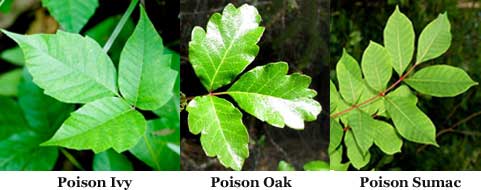Leaves of Three, Let Them Be

Poison ivy, poison oak, and sumac plants contain the oil, urushiol (yoo-roo-shee-ol). All of these plants grow in northern Florida and are encountered all too often when working or exploring in the woods. To differentiate the plants, it is helpful to know that poison ivy and poison oak generally grow three leaves per stem while poison sumac has seven to thirteen leaflets per stem. Oil from these plants can cause an allergic reaction that typically presents as redness, itching (sometimes severe), and blisters that may occur in a line on the skin.
Human skin contains enzymes that break down the urushiol oil within the first four hours of contact. If the oil is washed off in the first 5-10 minutes after exposure, this can prevent a rash from forming or limit its severity. After this time period, a rash will occur in at least 50 % of individuals exposed to the allergen and subsequent exposures may cause a more intense rash as one becomes sensitized. Blisters may form in hours, days, or even weeks after exposure and may occur in stages. It is important to know that this type of rash is not contagious and the fluid in the blisters cannot spread the rash. This is because the blister fluid does not contain the urushiol after the skin interacts with and absorbs it. Rather, the blister is a reaction to contact with the allergen.
The following measures should be considered for avoidance:
1) Wear clothing and vinyl gloves when working where one may encounter exposure. The oil can penetrate latex or rubber gloves and adhere to tools.
2) Wash any exposed skin with cool water and soap. Hot water can enhance absorption through open pores.
3) Wash clothes in hot water and detergent as soon as possible so that the oil does not come in contact with the skin again or spread the oil to other surfaces. Golfers should wash towels used while golfing if exposure to a poisonous plant is suspected.
4) Be aware that sources such as animal fur can contact and spread urushiol when going on walks, etc.
5) Avoid contact with any part of these plants, even when leaves are not present. The oils on any portion of the plant, including the roots, can stay active for many years after the plant is dead and become airborne when burned.
If a rash does occur, mild cases can be treated with hydrocortisone as directed. However, dermatitis (inflammation of the skin) caused by exposure to poisonous plants may become severe or flare intensely if insufficiently treated with medications over too short of a duration. Therefore, a medical provider should evaluate dermatitis caused by exposure to poisonous plants in determining the appropriate course of treatment.
About the Author
Larry Weidell, PA-C, is Board Certified by the National Commission on Certification of Physician Assistants and is a fellow member of the Society of Dermatology PA’s. He became a Physician Assistant in 2001, graduating from Union College in Lincoln, Nebraska. Larry has specialized in Dermatology since 2005 and has a passion for general medical dermatology. His goal is to provide exceptional customer service and individualized treatment plans for patients who desire improved skin wellness

